
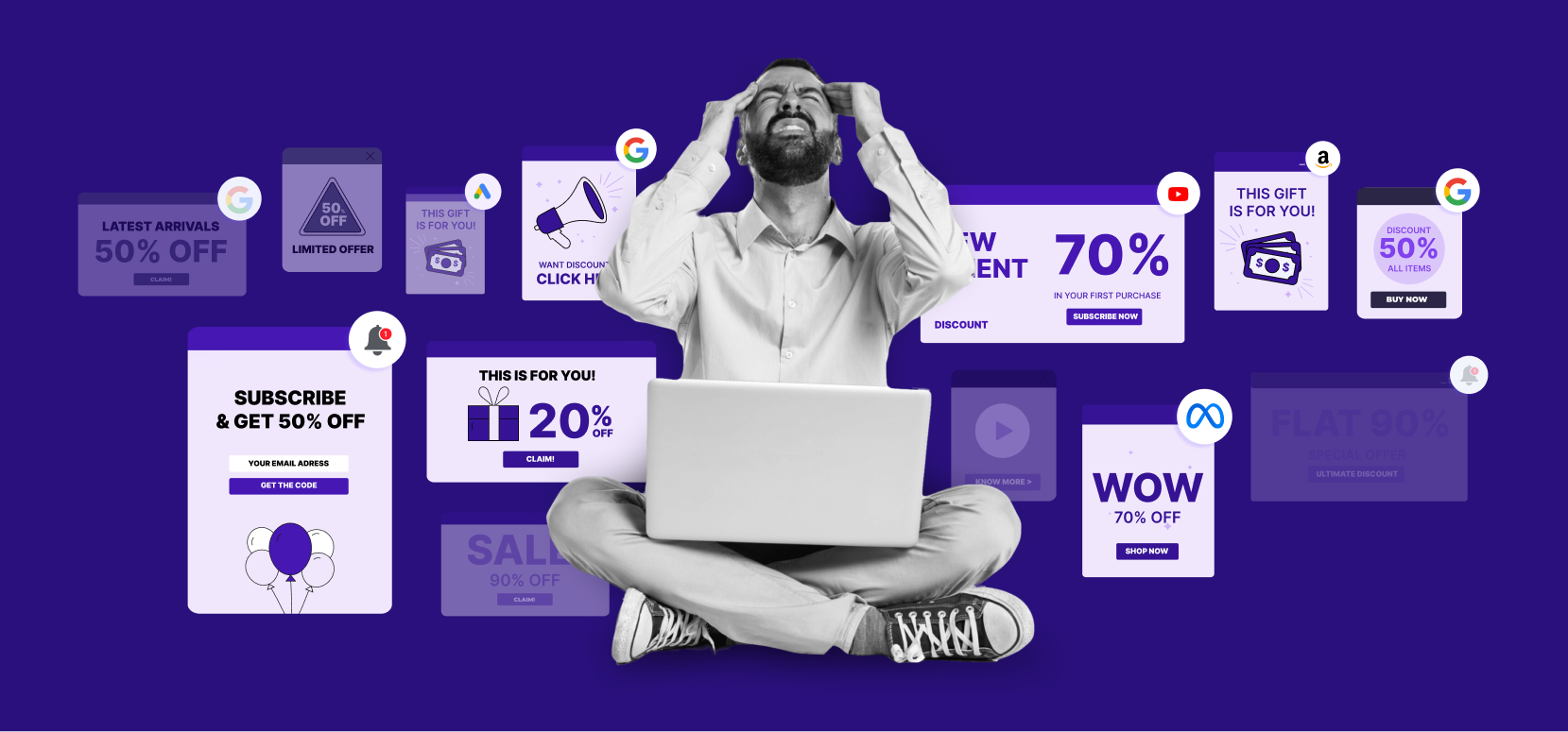
Navigating the role of an ecommerce category manager presents a unique blend of fulfillment and fatigue. The exhilaration of competing for attention and revenue against other categories present on the platform provides a surge of adrenaline. However, this thrill is coupled with a weighty pressure that quadruples during sale season, creating an environment that is, to put it mildly, utterly exhausting.
The life of an ecommerce category manager during a sale season is a far cry from the anticipation we, as customers, experience when eagerly awaiting grand shopping events. While we glow with the satisfaction of hugely discounted iPhone models, the ecommerce category manager and their teams are plunged into months of meticulous planning, sleepless nights, and endless preparations. This includes ensuring stocks and logistics are flawlessly executed, along with the creation of product banners and creatives that essentially compose the very essence of the sale storefront.
The demand for such creatives has surged over time, mirroring the escalating expectations of customers. Personalized product recommendations are just the tip of the iceberg; these creatives must undergo frequent refreshes to captivate customer attention and reflect the latest prices and offerings that need to change by the hour! Take, for instance, the fashion category of the world’s largest ecommerce platform required over 36,000 on-brand, designer-grade creatives during a single major annual sale event!
Despite this escalating demand for creatives, the surge in requirements has not been met with an equivalent efficiency in creating visuals, whether by in-house teams or agencies. Consequently, category managers and their teams find themselves stationed at the workplace during sale seasons, grappling with the seemingly unending need for creatives and visuals, and never enough bandwidth to produce them! Why? Despite technological advancements, creative processes remain entrenched in antiquated methods and legacy tools that cannot scale operations. So, the question arises: Is there a viable way to restore some much-needed respite in the life of category managers? Let’s explore.

In the day-to-day grind, ecommerce category managers aim not just to attract visitors to their category pages but also to convert them into customers. How? By running multiple campaigns simultaneously on their ecommerce site and various digital platforms like Facebook, Instagram, YouTube, and more. The success of these campaigns depends on having compelling, on-brand, personalized creatives that meet the requirements of each platform. However, producing this multitude of creatives, each tailored to different guidelines and dimensions is no easy feat. Let’s start with the entire manual process of creative production, one that is riddled with inefficiencies. Envision a team of designers toiling day and night, crafting an array of visuals for an upcoming sale. Yet, before completing this colossal task, a new demand surfaces—adapt these visuals to the dimensions of all social media platforms and personalize each in 10 vernacular languages. The result? By the time the designers were done, the requirements for the next sale had already started pouring in! After all, there’s a limit to which manual processes can scale, and that scale is anything but vast.
Now, let’s delve into another challenge that disrupts the peace of a ecommerce category manager—brand safety and compliance. Ensuring brand safety has perennially been a nightmarish task involving various individuals, including category managers. The ordeal includes manually scrutinizing every asset and creative to ensure that they comply with company guidelines, platform rules, and other legal prerequisites. Even the world’s largest ecommerce platform takes a stringent stance, rejecting almost 50% of creatives from brand advertisers that fall short of compliance, whether in terms of dimensions or branding. This rejection not only translates to significantly delayed campaign launches but also entails substantial revenue losses for the platform
Finally, let’s address the challenge of creative refreshes. Picture this scenario: watching the same episode of a TV show every single day—it sounds remarkably boring, doesn’t it? Audiences share a similar sentiment when repeatedly exposed to the same ad creative, leading to a state of indifference. As companies continue running campaigns with unaltered creatives, they often forget that the audience’s interactions with those ads dwindle, resulting in a waste of resources. Ecommerce Category managers find themselves on a perpetual quest to ensure the regular refreshment of product creatives within their designated category. This task becomes even more critical during peak sale seasons, when offers and discounts undergo daily if not hourly, changes. Failing to align ad creatives with the latest offerings poses the risk of losing customers to more nimble competitors.
However, as you might have already guessed, executing this is easier said than done. Category managers must meticulously track which creatives need to be refreshed and ensure that they are refreshed on time. Meanwhile, designers toil away, manually updating each creative with new offers, pricing details, or product images. Any missed opportunity to refresh creatives would mean plummeting performance, and missed revenue that goes to competitors that have won the race of putting out better offers, faster.
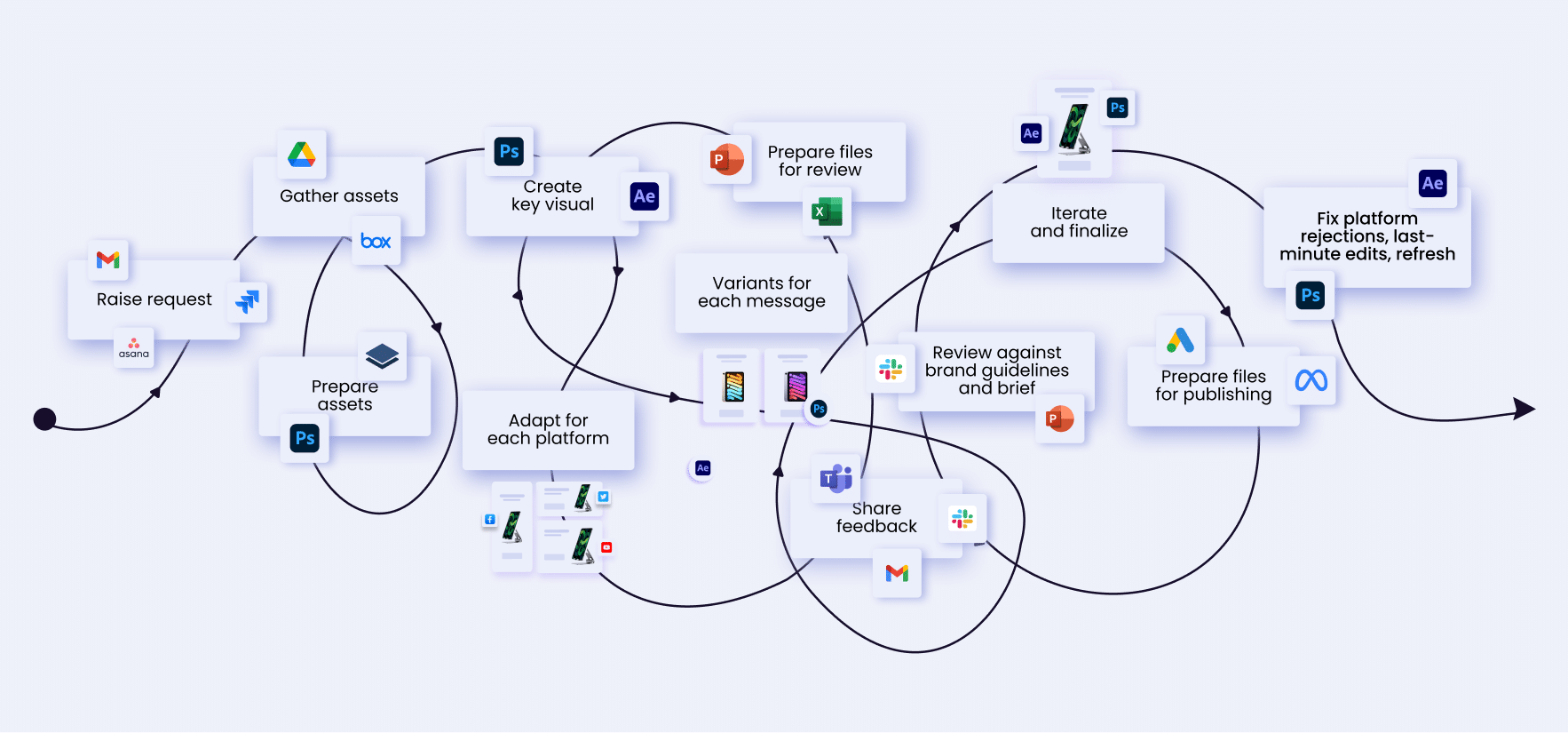
Stepping into the shoes of a category manager is no easy feat. In the quest to drive maximum sales for their category, these are just a few of the mountains that they need to cross:
By now, we’re well acquainted with what’s causing category managers to lose their precious sleep. But is there a way to return those coveted hours of rest without resorting to sleep aids? Turns out, there is!
The first step involves identifying the leaks in the entire creative operations system. Initially, the tools and processes prevalent across enterprises aren’t designed to scale. Take, for instance, the industry standard for design software, Adobe Photoshop. While it can work wonders in the hands of a seasoned designer, it falls short in supporting collaboration or crafting visuals at the immense scale demanded by most ecommerce platforms.
What we’re discussing here is nothing short of a CreativeOps revolution—an overhaul of a convoluted infrastructure bleeding time and money, transforming it into intelligent creative operations that render a brand’s communication infrastructure more agile. The aim? To ensure that scale and speed are no longer formidable challenges.
Let us illustrate. We recently took a sneak peek into a day in the life of category managers and witnessed their daily struggle to launch a campaign. Now, let’s envision what a day in their lives could resemble with the support of intelligent and agile CreativeOps.
Imagine saying goodbye to the old days of scattering campaign requests across multiple platforms, risking them getting lost in the shuffle. Now, campaign managers can streamline the process with efficient creative request management. They draft detailed briefs, powered by AI support, and assign tasks to team members—all in one coherent platform with timely notifications
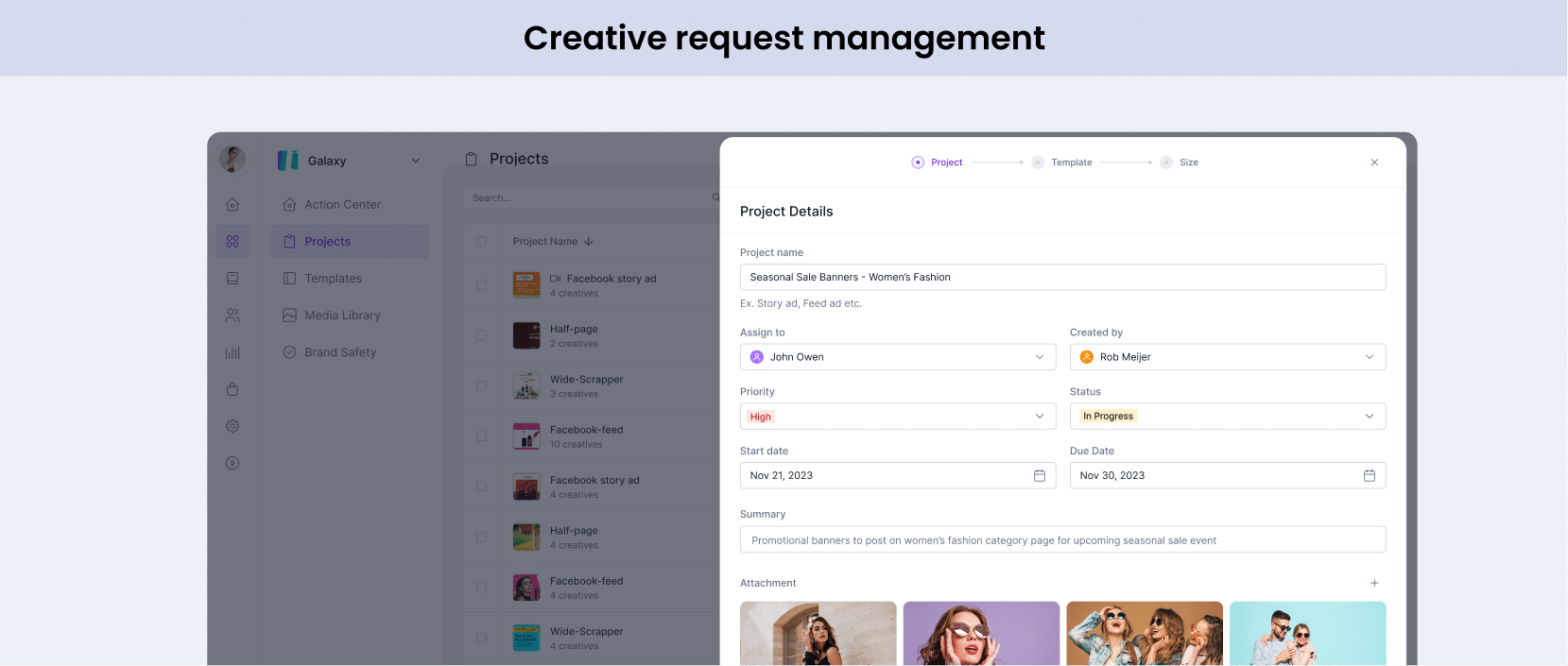
Scouring through endless Google Drive and Dropbox folders for that one creative only to realize that it is in the personal hard disk of an ex-employee will become a thing of the past. With intelligent digital asset management powered by auto-tagging and global search, finding any and every creative will just be a matter of a few clicks.
With all important creative brand assets in place and tagged, designers can start working on creating key visuals and templates seamlessly. Have key visuals created on external platforms like Photoshop Import them with a simple drag and drop and let designers start weaving their magic.
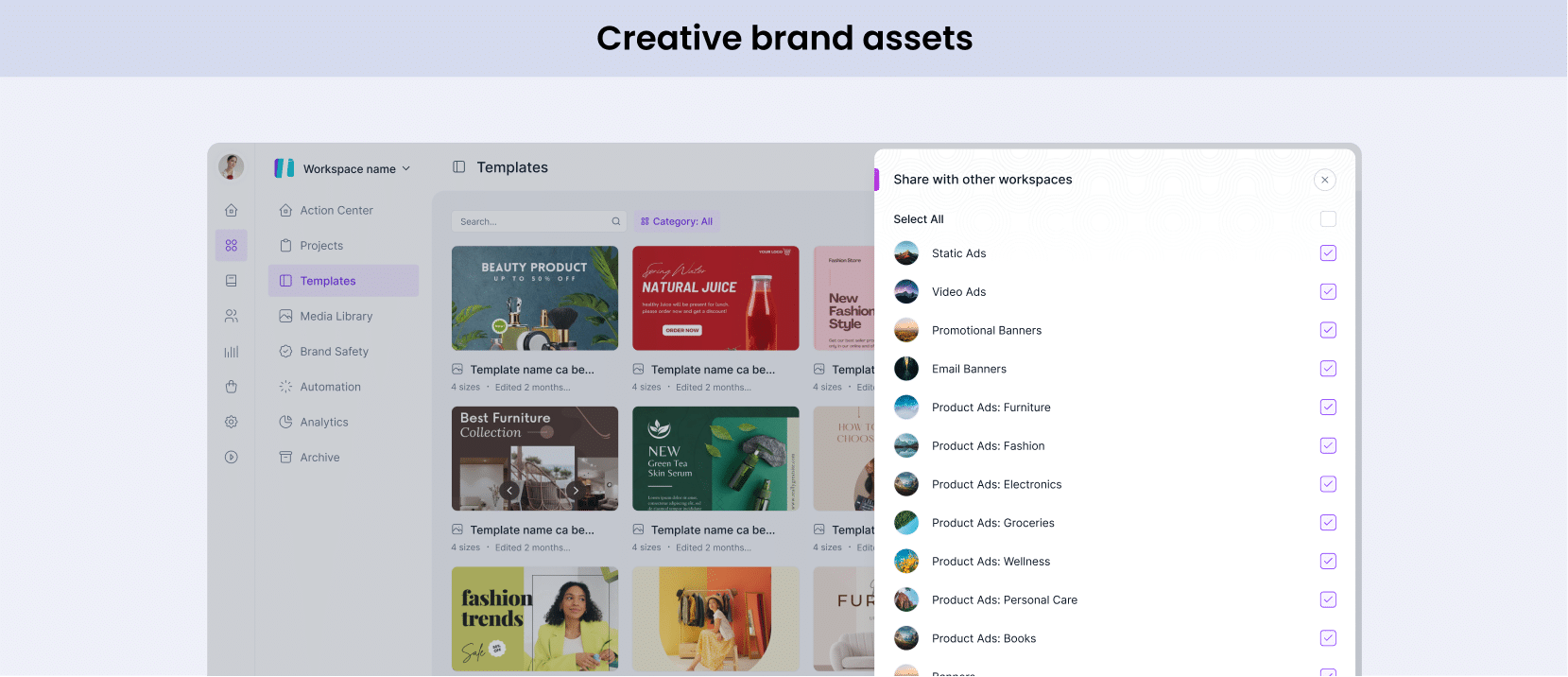
Key visuals locked and loaded? Now brace yourself for the climb – adapting for different platforms, products, sizes, and beyond. But what if we say that the Herculean task of personalization and localization can become child’s play, thanks to seamless design scaling. Single visual, multiple dimensions – done in a snap. Copy changes across thousands of visuals? Bulk editing to the rescue. And no more sleepless nights for category managers fretting over personalization. A simple spreadsheet import, and voilà – multiple personalized variants ready in minutes, not days! Time to refresh campaign creatives? Category managers or designers can smoothly handle it using self-serve editors, ensuring lightning-fast creative updates.
Review time – the moment of truth for creatives. As crucial as it gets, ensuring each piece aligns with brand rules and guidelines is a task worthy of a superhero. But fear not, our seamless creative approval system is here to be your caped savior. Set up brand rules on the platform and viola! Every creative is scrutinized against those rules, notifying designers of the slightest deviation. Team members? They drop feedback directly on the canvas, and issues vanish without a feedback labyrinth. Streamlined and simplified, – just the way creativity should be!
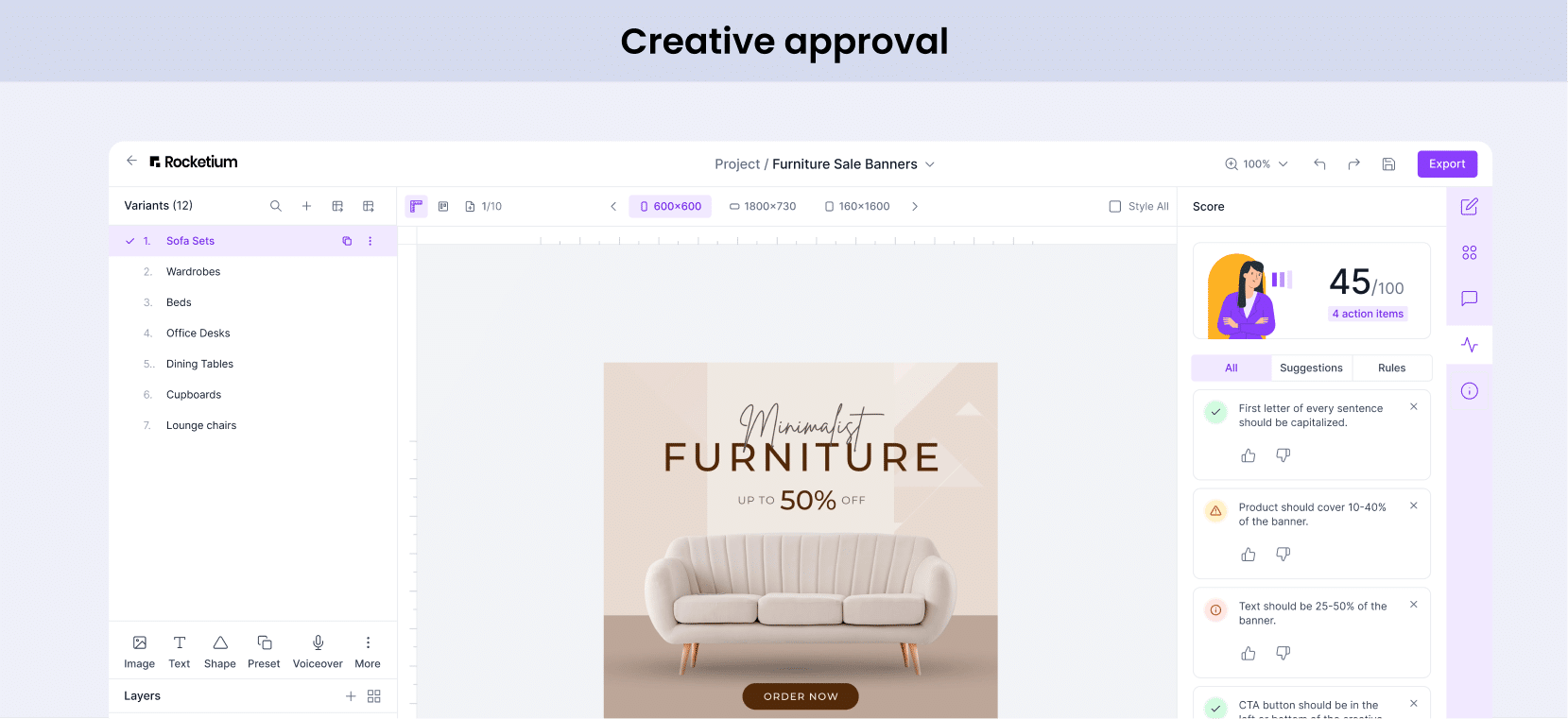
Challenge
This retail leader sells 150M+ SKUs across various categories, to their 400M+ customers. Their category teams worked with the central creative team to produce and refresh creatives for category pages. As the central team supporting various categories, the designers were always choked for bandwidth and offered an average turnaround time of 4 weeks for new requests. Additionally, updating creatives and offers real-time, during sale events were almost impossible with the pace and scale of iterations required.
Solution
Rocketium empowered the retail leader’s design team to supercharge creative production with automation. Designers leveraged templates and Rocketium’s AI-powered automation to create variants and sizes, reducing average TAT for new requests down to 2 weeks. Updating live offers also became easier with Rocketium’s self-serve editor, allowing category teams to make bulk updates and go live with just a few clicks. With Rocketium, the teams were able to launch and refresh 150K+ creatives per sale, boosting sales revenue for the ecommerce giant.
Impact
140k+ Creatives went live in a week
12X Faster TAT
Challenge
The fashion category teams at this ecommerce leader promote 1M+ products from thousands of private-label clothing brands. The scale of creatives required for this led these category teams to hire agencies to support their creative teams. This entailed expensive retainers and significant bandwidth spent in coordination and reviews. Since the agencies worked with traditional tools and manual workflows, turnaround times were high and go-lives were frequently delayed.
Solution
Rocketium’s team of tech-enabled design and domain experts helped boost creative production for the ecommerce company, at half the cost. By leveraging Rocketium’s CreativeOps platform, the team effortlessly produced on-brand creatives at scale. With automated brand safety checks and seamless collaboration executed directly on the designs, the ecommerce leader’s fashion category teams go live with creatives faster, for improved outcomes.
Impact
52% savings on production costs
73% faster go-lives
Challenge
With a presence in 11 countries across Africa, this ecommerce leader locally promotes millions of products to various demographics. As their video ads drove higher engagement than static-rich media, they decided to invest in producing localized videos for various countries. But their creative teams lacked the tools and workflows necessary, incurring long turnaround times and high production costs.
Solution
Rocketium’s powerful video production capabilities enabled the African ecommerce leader to insource video production with minimal costs. With automation features, powerful design tools and branded templates, the teams effortlessly produced and published thousands of on-brand product videos in multiple languages for 11 countries in just a few hours. This helped them drive higher engagement and conversions on their website, boosting ecommerce sales across countries.
Impact
4.5x more videos produced for the website
60% higher click-through on video banners
Challenge
The grocery delivery marketplace team of this ecommerce leader aimed to personalize customer communications to boost traffic to their store. To achieve this, the category team decided to personalize push notifications and enrich them with personalized creatives. But, they neither had the right design tool to generate personalized banners at scale nor the operational bandwidth to deliver these to different audiences. This forced them to use text-based push notifications, which didn’t drive engagement as effectively as expected.
Solution
Leveraging Rocketium, the category team generated 2.7K+ personalized banners using on-brand templates and a simple content feed. With streamlined CreativeOps driving seamless reviews and quick iterations, they were able to go-live with rich media push notifications in just a few hours. With personalized communications for 1400+ cohorts countrywide, the grocery delivery marketplace team achieved higher engagement and revenue during sale events.
Impact
15% higher engagement on personalized rich media push
8% higher revenue from sale events
Rocketium has empowered online marketplaces around the globe to streamline their creative operations helping them boost category sales by iterating offers quickly and launching campaigns faster. Get in touch with us at marketing@rocketium.com to know more.